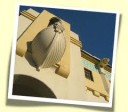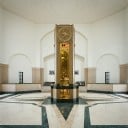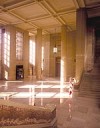
On June 9th, 2011, Canada Post began issuing a new series of stamps celebrating Canadian buildings designed in the Art Deco style. This style, popularized after World War I was widely used around the world in the 1930s and until the 1940s. The Art Deco style relies heavily on linear, geometric shapes and was a departure from the curving, flowing and romantic shapes of the previous styles. Despite its more agressive lines and imposing shapes, Art Deco still manages to maintain an elegance and grace that is pleasing to the eye and convey a sense of luxury to the beholder. The following five Canadian buildings will be featured on the new stamps.
The Burrard Bridge

This bridge provides crossing over False Creek in Vancouver, British Columbia. An impressive overhead structure greets motorists, decorated with sculptural details like ship prows and busts of Captain Vancouver and Sir Burrard-Neale and lion’s heads. Fancy windows and street lamps also

embellish the bridge. One distinctive feature is the fact that all the steel trussing located overhead in the center of the bridge is hidden from view as you drive up by the elaborate concrete entrances at either end. Also, on either side of the bridge are pierced railings spaced in such a way that when you drive through at around 50 km/h, you seem to have an unobstructed view of the water.
The R. C. Harris Water Treatment Plant

This beautiful building is elegant and awe-inspiring at the same time. It stands out from its surroundings with its arching windows and sculptural details, almost looking like a fortress or a castle in the distance. Not only is the exterior beautiful, but the interior takes the breath away. Marble floors, stairs and columns grace the entrance as well as a retro-style clock with brass detailing. Vaulted

ceilings, domed ceilings and windows with lead detailing or stained glass provide even more glamour. Even the pump room with its teal-blue coloured pumps on terra-cotta tile is beautiful. The building was so sumptuous that early critics called it ‘The Palace of Purification’. Its distinctive look has made it a popular choice for film producers and the building has been featured in several popular movies.
Cormier House

Located in Montreal, Quebec, Cormier House was designed by Ernest Cormier to be his own home. Cormier was a famous Art Deco architect who is responsible for creating some of the most beautiful buildings in Canada and the United States. In modern times, the home also used to house Pierre Elliot Trudeau. It is unfortunate that this beautiful house cannot be toured (it is privately owned), because it is considered to be one of the best examples of Art Deco architecture in the world. The

concrete exterior is stately but quietly graceful at the same time. A sculpture of a woman in a flowing gown adorns the entrance. The interior furnishings are a perfect example of Art Deco decorating.
Supreme Court of Canada

The Supreme Court of Canada Building was also designed by Ernest Cormier. The

imposing look of this structure is appropriate given that inside the building the most important decisions and rulings of our nation take place. An impressive entrance with marble stairs and walls leads up to courtrooms and offices which also feature rich detailing.
Dominion Building

The Dominion Government Building is located in Regina. An interesting feature of this Art Deco building is the use of Tydall stone, a fossil-bearing stone, in its building materials. At ground level on the exterior you can view fossils in the stone used on the base.
I love this post because it’s so informative about the Deco buildings. I just referenced the post and linked to this site from my Canadian Art Junkie blog at https://canadianartjunkie.wordpress.com Thank you. J Walters